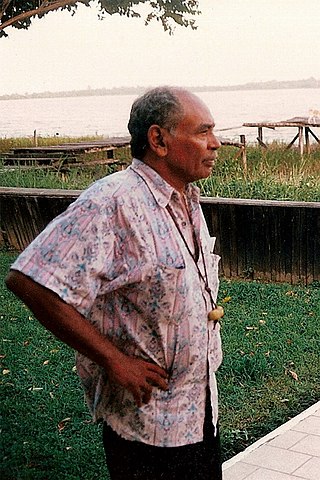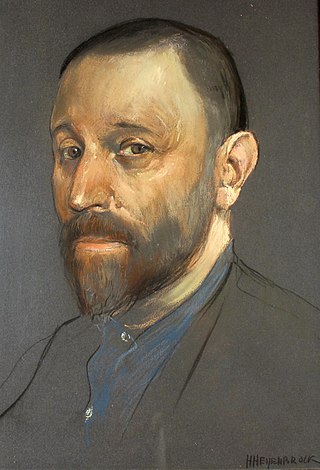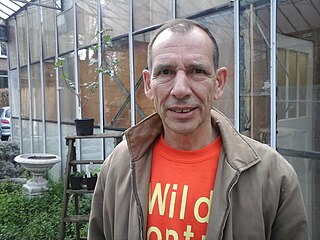Livinus van de Bundt was a Dutch artist, [1] who called himself Livinus. [2] Initially a painter and graphic artist, he was the founder of an art academy and later became a pioneer of light art and video art.
Livinus van de Bundt was a Dutch artist, [1] who called himself Livinus. [2] Initially a painter and graphic artist, he was the founder of an art academy and later became a pioneer of light art and video art.
Livinus Arie Cornelis Jan van de Bundt was born 5 March 1909 in Zeist. [1] His father was Jan van de Bundt (1887–1970), his mother Sijgje Cornelia van der Vlies (1885–1961). Livinus had two sisters, Corry and Kiki. [3]
Livinus started painting aged 14. [4] From 1929 to 1931 he worked for Koninklijke Begeer. [5] He enrolled at the Koninklijke Academie van Beeldende Kunsten in The Hague in 1932, but left prematurely in 1934 after a number of conflicts. [5] In 1937 he went to Paris to study with Stanley Hayter at Atelier 17 for a year. [1] [4]
A 1938 exhibition of his abstract work was not well received, provoking him to destroy his work. [6] [4] At age 30 he gave up painting, unable to achieve the brilliance he envisaged. [6] [4] For several years he produced only graphic work in black and white. [6]
During World War II Livinus van de Bundt applied his graphic skills to forge passports. [7] In 1947 he founded the Vrije Academie voor Beeldende Kunsten in The Hague and remained its director until 1964. [8] [2] His work was also part of the painting event in the art competition at the 1948 Summer Olympics. [9]
He started working with light, using a variety of materials. His chronopeintures contained illuminated pieces of colored plastic. [4] Livinus' secretive luminodynamical machine, built in the 1950s from lenses, bulbs and electronic components, enabled the operator to generate color effects using a keyboard. [6] [4] He built a drum kit which triggered light effects when hit. [6]
Van de Bundt married Mieke van der Burgt (18 April 1917–9 June 1979), herself an artist working in graphics, ceramics and textiles. [10] The pair had a daughter, Livina van de Bundt, [11] and a son, Jeep van de Bundt, who became an artist, musician and later a classic car dealer. [12] [13]
In 1970, while on a visit to Intermedia [14] in Vancouver, Livinus started experimenting with video. He produced several video art projects, together with his son. [4]
Livinus van de Bundt died 11 October 1979 in The Hague. [1]
Incomplete list of extant and lost works:

Van de Bundt was awarded the 1964 Sikkens Prize for his fotopeintures. [25] In 1965 he received the Soclair prize for his Optochrome constructie variabel 40 b 3. [26]

Ed Gebski is an artist from Amsterdam. His monumental canvasses are created in a darkroom where he works with silver-nitrate/oil paint. Only when the paintings are exposed to light do they reveal their colour and presentation. This process is akin to the development of photographs. The paint emulsion is removed after the painting process and then transparent colours remain on the canvas.
Vrije Academie voor Beeldende Kunsten was an art school in The Hague, Netherlands. It was founded in 1947 by Livinus van de Bundt. The last remaining part of the school, GEMAK, closed on December 4, 2015, after a 75% cut in its funding from the city of The Hague. The final product of the school was the publication Exit GEMAK: All Art is Political | Kunst = Politiek.
Carel Balth was a Dutch artist and curator.

Antonio Jose Guzman is a Dutch Panamanian visual artist, communication designer and lecturer. He lives and works in Amsterdam, Panama City and Dakar.

Erwin de Vries was a Surinamese painter and sculptor.
Hermanus (Herman) Berserik was a Dutch painter and print maker. He was a member of the Pulchri Studio in The Hague. He studied art at that city's Royal Academy of Art, where his teachers included Willem Schrofer, Willem Jacob Rozendaal, and Rein Draijer.

Herman Heijenbrock, was a Dutch writer, painter, pastel draughtsman, and lithographer. He founded the "Museum van den Arbeid" in 1923, which later became NEMO Science Museum.

Pieter Abramsen was a Dutch sculptor, and visiting professor at the Delft University of Technology, known for his work in which abstraction and realism are joined.

Jan Hillebrand Wijsmuller was a Dutch painter. He belongs to The 2. Golden Age of Dutch Painting.

Johannes Jacobus (Jan) van der Vaart was an influential Dutch ceramicist from the 20th century, known as founder of the abstract-geometric ceramics in the Netherlands.
Daniël (Daan) van Golden was a Dutch artist, who has been active as a painter, photographer, collagist, installation artist, wall painter and graphic artist. He is known for his meticulous paintings of motives and details of everyday life and every day images.
Airco Caravan is a painter and conceptual artist based in Amsterdam and New York City.

Bernardus Stefanus Henricus (Ben) Zegers is a Dutch visual artist, active as a sculptor and installation artist, and teacher and coordinator at the Gerrit Rietveld Academy.
Thomas Meyer zu Schlochtern is a Dutch art historian and curator, who came into prominence as director of the Arti et Amicitiae and as curator at Rotterdamse Kunststichting in the 1990s.
Jeroen Eisinga is a contemporary video artist from the Netherlands. His work is characterised by its performance like character and its plots where an ordeal is often central. Simplicity is of key importance to Eisinga. His work is shot on film and is shot on 16mm as well as on 35mm format film.

Marie Heijermans or Marie de Roode-Heijermans (1859-1937) was a Dutch painter.

Frederika Henriëtte Broeksmit (1875–1945) was a Dutch artist and peace activist.
Gerardina Anna Allegonda Martina Hooft (1894-1994) was a Dutch painter know for her still lifes.
Agnes Johanna Elisabeth van Stolk (1898-1980) was a Dutch artist.
Cornelius Hendrik Rogge was a Dutch sculptor, installation artist and painter.